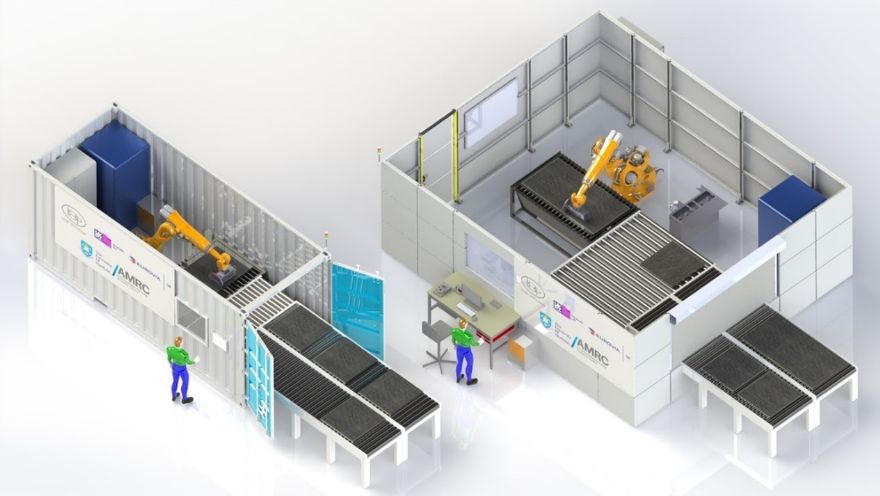
A ground-breaking robotic paving slab cutting process, harnessing innovative digital technologies such as artificial intelligence (AI) and automation, is being developed for the construction industry to improve productivity and safety while reducing waste and disruption.
The Distributed Automated Cutting System (DACS) project, led by
Eurovia UK in partnership with
Loop Technology and the
University of Sheffield Advanced Manufacturing Research Centre (AMRC), will use a suite of advanced digital technologies to produce bespoke, made-to-measure slabs in a controlled environment, minimising on-site disruption and helping accelerate the UK’s urban regeneration.
The process of developing and testing automated cutting robots can be complicated, with high initial investment and resources needed. The £500,000 DACS project which will run until April 2022, is funded through the UK Research and Innovation (UKRI) ‘Robotics for a more resilient future’ competition, and brings together the partnership’s skills and expertise to remove these financial barriers.
Andrew Tyrer, challenge director at Robots for a Safer World (UK Research and Innovation), said: “As we look to recover from the Covid-19 pandemic, the opportunities for robotics have never been greater. With net-zero ambitions underlying industrial plans in every sector, and the chance to rebuild new industries after the pandemic, robotics, artificial intelligence (AI) and automation are vital ingredients.
“The UK is a world leader in the field of robotics thanks to projects like DACS and we look forward to seeing the impact this innovation has on the construction sector.”
New paved areasThe growing demand for pedestrianisation, to reduce the impact on air quality and climate change, is resulting in local councils undertaking more infrastructure projects that involve laying new paved areas. These can take from several months to a few years, sometimes causing widespread disruption including road closures and noise for residents and the public.
Paving slab cutting, to fit into gaps or around street furniture, is one of the bottlenecks of paving operations. On-site cutting can create safety risks to the workforce and disruption and environmental nuisance to the general public.
Modern Methods of Construction (MMC), incorporating metrology, robotics, AI and off-site processing, will be used within the project to reduce disruption from paving operations, while improving productivity, safety and environmental impact.
Phil Reid, Eurovia Contracting’s digital construction manager, said: “This project is literally breaking new ground to bring automation to our public spaces. Cutting paving slabs on site is a messy, noisy and timely process — both for local people and our own workforce.”
“DACS will modernise paving operations to deliver a safer and environmentally friendly process along with a 40 to 50% improvement in productivity. For a typical year-long scheme this could cut disruption by almost a month.
“This partnership is bringing together expertise from the highways and construction sector, artificial intelligence and robotics to design out waste and risk and deliver a new process on the ground that reduces waste, noise, dust and the inconvenience associated with public realm improvements.
“We think that this project has the potential to revolutionise the way we deliver on site and cannot wait to deliver it for local councils and local people.”
Compact and containerised systemInitial stages of the project will see a robot cell created at the AMRC’s flagship Factory 2050 facility. This will be followed by the development of a compact and containerised system making DACS accessible anywhere.
Ejae Perez, a senior project engineer at the AMRC, explained that DACS will scan data from areas to be paved and automatically create robot cutting paths. AI will then be employed to assess the available slabs and offcuts to choose the optimal piece to maximise material usage and minimise waste.
He said: “We are delighted to be working with Eurovia and Loop Technology to overcome challenges within the industry by using our expertise in digital and automation manufacturing technologies and to help the sector embrace MMC to build back better and improve productivity, safety and reduce waste.
“Our role will be to introduce automation to replace a time-consuming and manual process. We aim to introduce digital manufacturing technologies such as automated cutting optimisation through AI to reduce stone wastage and robotic machining to cut paving stones to the required shape.
“Automating this process will allow cutting of paving stone off-site in the factory, removing any health and safety implications and improving quality and productivity on-site.”
The technology developed by the consortium will work in a wide range of applications where paving slabs are cut and showcase the potential of robotics in the construction industry. The project also supports Government aspirations laid out in the
Construction 2025 Industrial Strategy to improve project outcomes in terms of cost, time, safety and sustainability.
Other key benefits of DACS include: cutting can be moved off-site to eliminate on-site noise, wastewater and carcinogenic silica dust and other hazards; reducing the extent of road and footway closures where cutting would normally occur with ad-hoc fencing around a large safety radius;
improving worker safety by removing manual site cutting operations and exposure to noise and vibration; and reduced waste paving from 10 to 3% by optimising cutting patterns.
For a typical contract this would save about around 16 articulated lorry-loads worth of waste; making best use of a limited pool of specialist, skilled paving teams.